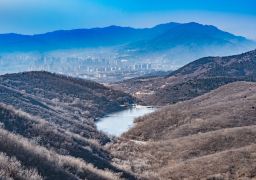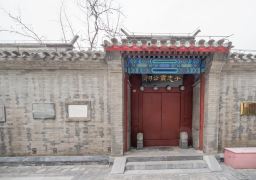Introduction: An academy in the late feudal period of China. Located within Qianshan County, Guangxin Prefecture, Jiangxi Province. Since the Eastern Jin Dynasty, through the Tang, Song, and Ming dynasties, many scholars have gathered here and it was once a cultural center. Especially the Ehu Meeting between Zhu Xi and Lu Jiuyuan became an influential event in the history of Chinese Confucianism. According to the ‘Records of Guangxin Prefecture’: ‘To the left of Dayi Temple is the Temple of Four Sages.’ This is actually attached to the left side of Dayi Temple, that is, to the left of Renshou Temple, and is the ‘Temple of Four Sages’. The temple was built by Yang Ruli, the governor of Xinzhou at that time, which was the beginning of Ehu Academy. Later, there were many renovations. After the chaos of Chen Hao in the Ming Dynasty and in the aftermath of war, all the school buildings of Ehu Academy were destroyed. In 1683, the local official Pan Shirui repaired it. In 1715, the magistrate Shi De greatly renovated it. At that time, Li Guangdi’s ‘Record of Rebuilding Ehu Academy’ said: ‘The construction of the academy is actually a national school, complementing each other. Li Bo is a lofty scholar. Zhu Xi is still deeply concerned. Now, making the ruins of the sages renovated splendidly again. In the old place of Neo-Confucianism, there must be people who visit here and be inspired to carry forward the predecessors.’ With the official support, Ehu Academy was rebuilt. The former glory has never reappeared and it has become a historical relic. Ehu Academy is on the left side of Ehu Temple, that is, Renshou Temple, and Ehu Pagoda is on the left side of Ehu Academy. The gate of Ehu Academy is not in the center but on the left, so it is directly facing Ehu Pagoda. Around the academy, there are mountains and streams, and the environment is elegant. Ehu Academy is much larger than Ehu Temple, and its architectural scale is similar to that of the Confucius Temple. Entering through the gate, after passing two rows of peach trees, there is a large round gate. Inside the round gate is a large courtyard. Opposite is another large round gate. Above are three rows of halls. Entering by climbing the stone steps, there is another courtyard. Inside is a semicircular pool, and around the pool are stone railings. Crossing the ancient bridge is the first row of halls. After passing through another courtyard, it is the second row of halls. Behind it is a row of halls, which is the Temple of Four Sages. In front of the temple is also a courtyard. Behind the temple is a rather high platform. Under it is a small pool. Behind it is a high wall, directly facing the northern end of the high wall of the two large round gates. These three rows of halls are the main house. On both sides of the main house, there are rows of houses, in an orderly manner. Inside the Temple of Four Sages behind Ehu Academy, there are four memorial tablets for Zhu Xi, Lü Zuqian, Lu Jiuyuan, and Lu Jiuling. There is also a plaque inscribed with the words ‘Return to the Same by Gradual and Sudden’. This is exactly opposite to the imperial plaque inscribed with ‘The Origin of Neo-Confucianism’ hanging in the front row of buildings of the academy, which shows the grand occasion of the Ehu Meeting between Zhu Xi and Lu Jiuyuan in the Song Dynasty. During the War of Resistance against Japanese Aggression, Ehu Academy became the stationed camp of the Southeast Training Regiment. This academy, from the Southern Song Dynasty to the Qing Dynasty, for more than 800 years, has been destroyed by war several times and rebuilt several times. Especially in 1717 of the Qing Dynasty, the renovation and expansion project was on a large scale: a new mountain gate, archway, main hall, floating pool, arch bridge, stele pavilion, and imperial library building were built; dozens of wing rooms were built on both sides as places for scholars to study.
Emperor Kangxi also inscribed and composed couplets for the imperial library building. The lintel is titled ‘Pursue Principles and Reside in Respect’, and the couplet reads ‘The moon over Zhangyan is like a mirror in the sky, and the waves in the stone well are like the spring of Taiji.’ Up to now, buildings such as the memorial archway, the pool in front of the school, the rear hall, and the wing rooms are still relatively well preserved. In the wing rooms on both sides of the pool in front of the school, there are still 13 ancient steles from the Ming and Qing dynasties, which are precious materials for studying the history of this academy.
Opening hours: Open all year round from 09:00 to 17:00. Preferential policies: Supplementary note: 1. Free policies: Active-duty soldiers with valid certificates; press cards and photojournalist cards issued by the General Administration of Press and Publication or the State Administration of Radio, Film and Television; membership cards of photographers’ associations; religious people with ordination certificates, conversion certificates, religious conversion certificates, and ordination records; people aged 70 (inclusive) and above, children under 1.2 meters in height (exclusive); national tour guides and Jiangxi tour guide certificates; people with disabilities; residents of Ehu Village can enter for free with their ID cards. The above personnel need to show relevant certificates and are limited to themselves for free admission. 2. The above information is for reference only. The specific information shall be subject to the disclosure on the day at the scenic spot. 3. Preferential policies: Children between 1.2 meters (inclusive) and 1.4 meters (exclusive) and students with student ID cards can purchase half-price tickets for themselves (children under 1.4 meters need to enter the scenic area for sightseeing under the guardianship of their guardians). (For the above preferential policies, tickets need to be purchased at the scenic area on their own).








